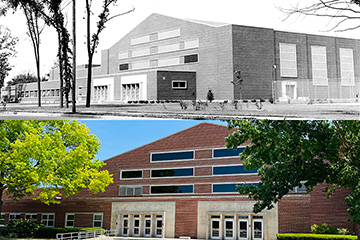Bringing distance learning closer
K-12 success relies on students’ connections to teachers and peers, not just tech
Experts on Point is a University Communications series focusing on CMU faculty who have special insights into interesting, important and timely topics.
Just weeks into America's first back-to-school season of the COVID-19 era, many students, teachers and schools are still finding their way in unfamiliar territory.

Troy Hicks aims to be a trail guide. The Central Michigan University professor in Teacher Education and Professional Development and director of the Chippewa River Writing Project is helping educators meet the challenges of remote teaching and learning. Hicks said many districts are connecting all students with devices and Wi-Fi access, but technological solutions go only so far.
"We have more technical connectivity, yet we run the risk of losing human connectivity," he said. "The challenges for all educators, teaching all age levels, is to build and maintain relationships with their students, and to help their students collaborate and connect with one another."
We asked Hicks to share more of his perspective on current issues in education.
How are you supporting K-12 success during the pandemic and beyond?
A: This summer, the Chippewa River Writing Project hosted a successful two-week virtual institute for two dozen teachers and a one-day event for over 60 teachers. This fall, we are offering a series of free webinars focusing on ways to engage students — face to face and remotely — in meaningful literacy learning.
Some colleagues from the Chippewa River Writing Project and I have produced a "quick reference guide" for remote literacy learning, with tips for connecting with students, which will soon be published by W. W. Norton.
Most recently, I worked with colleagues in the College of Education and Human Services and the state of Michigan to virtually convene educators from across the state to address digital learning. We structured the convening to give everyone a chance to share what's working well, challenges, recommendations and successes. As digital learning continues, we hope to carry on with the conversations to make progress supporting digital learning and equity.
Learning opportunities
The Chippewa River Writing Project's next free webinar, Oct. 20, is titled "Using Break Out Rooms Effectively in a Writing Classroom." Educators who teach kindergarten through college level are invited to register. Hicks said the group also is considering hosting virtual professional learning opportunities in partnership with districts. He invites educators to contact him at troy.hicks@cmich.edu
What would you say are the top needs for successful remote learning?
A: There are three key elements that we can focus on this fall, assuming that most students are connected with a device and Wi-Fi access:
- Build relationships: Most educators spend a good deal of time at the beginning of the school year building relationships with their students. This year we need to be sure to take extra time to learn about them, about their needs and
how they feel about school, about learning and about their lives.
- Frontload instruction: Most educators have a variety of ways that they can engage students, get them working with classroom activities and assess their learning through assignments. Walking into a classroom on any given day, a strong teacher will be able to make all of these moves and respond to student needs in real-time. When we teach online, we need to make more of these moves explicit to students, and we need to do so earlier, through announcements as well as in our video class sessions.
- Get creative with assessment: Most educators rely on a few tried and true assessment techniques, namely quizzes or tests, essays, and projects. Given that nearly all students have digital devices now — and we have access to many free tools for creating digital content — we can and must become more creative. For instance, how might students demonstrate mastery of a math calculation by recording a screencast? How might students create an infographic to complement a research paper? How might students develop a digital portfolio in the form of a website? Let's take advantage of the digital tools that students have at their fingertips.
What advice can you offer parents wanting to support their students and schools?
A: We can listen. This seems obvious, yet I mean we need to do more than ask, "How was your day?" and confirm that homework is being turned in. We can ask our students to share something that they learned by explaining it or giving us a quick "tour" of their work onscreen. We can ask how they feel about what they are learning and how they might be able to connect it to their own lives. And if they can't answer that question, we can help them discover an answer. It is time to make the work of school more relevant to the questions that students have in their lives.
In order to support our schools, we can step away from the screen, stop checking grades each day and ask teachers about the kinds of questions we should ask our students.
About the expert
A former middle school teacher, Troy Hicks has earned CMU's Excellence in Teaching Award, is an ISTE-certified educator and has written numerous books, articles, chapters, blog posts and other resources broadly related to the teaching of literacy in our digital age. He blogs at hickstro.org, and you can follow him on Twitter: @hickstro.




